Anarchy in the UK
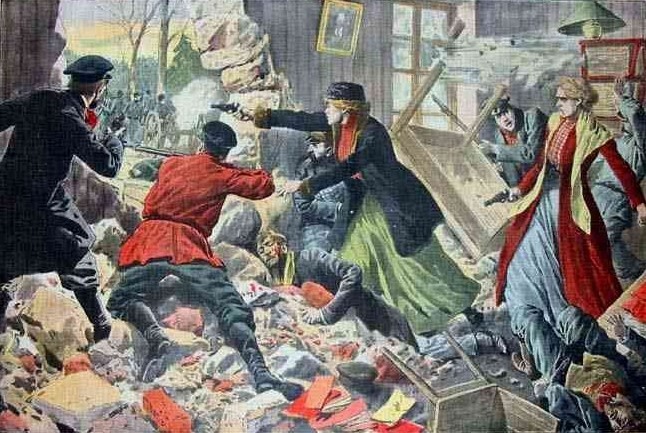
Over one hundred years ago the British government, controlled by the Liberal Party, had an open-door policy towards political refugees which led to anarchy in the UK.
The Liberal government welcomed anarchists and extreme, left-wing revolutionaries from all over continental Europe.
This policy had unforeseen consequences.
Three events took place in London from 1909 to 1911 which brought anarchy to the attention of the British public:
- The Tottenham Outrage
- The Houndsditch Murders
- The Siege of Sidney Street
Anarchists in London
In 1905 there was a failed uprising in Latvia (a province of Russia at that time), and after this, Latvian anarchists sought refuge in Britain.
It wasn’t just Latvian revolutionaries that sought refuge in Britain.
Every anarchist and political assassin from Europe seemed to be drawn to London and given asylum.
Shockingly, the Liberal government of the day was determined to allow political refugees into Britain even if those refugees had committed murder as long as that murder was politically motivated.
This open-door policy of the Liberals caused the then former head of the CID, Sir Robert Anderson, to call Britain ‘a cesspool for the scum of creation’.
A newspaper editorial at the time titled ‘Anarchists in London’ summed up the situation that existed in the 1900s:
Anarchists have been a serious social problem in Europe for the last 30 years since many of them adopted the policy of blind terror and assassination to destabilise bourgeois society.
Most anarchy occurred in mainland Europe and Russia, and so it never was a serious issue in Britain.
However, three events took place in London during 1909 to 1911 which brought anarchy to the attention of the British public: ‘The Tottenham Outrage’, ‘The Houndsditch Murders’, and ‘The Siege of Sidney Street’.
The Tottenham Outrage 1909
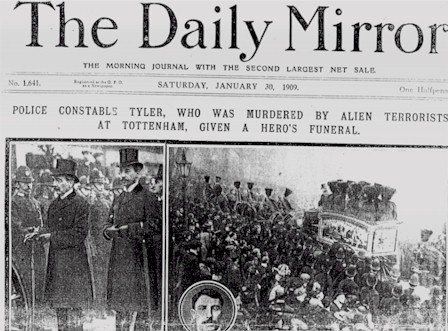
On the 23rd January 1909, a robbery by two heavily-armed immigrants (known as ‘Jacob’ and Paul Hefeld) set off the most extraordinary manhunt ever seen in the streets of London.
The six-mile chase which had lasted for over two hours left a trail of carnage through the streets of Tottenham (in north-east London) and surrounding areas.
When the chase was over, one policeman and a ten-year-old boy were dead; fifteen of the pursuers on the chase had gunshot wounds.
Both anarchists shot themselves in the head; one died instantly, and the other lingered on for weeks until his death.
The anarchists had a motto—never surrender!
Both the gunmen came from the Russian Baltic province of Latvia and had connections with anarchist groups.
Three thousand police escorted Police Constable Tyler’s coffin the two and a half miles from Tottenham to Abney Park Cemetery in Stoke Newington.
Up to half a million people went out on the streets to see the funeral procession.
The Houndsditch Murders 1910
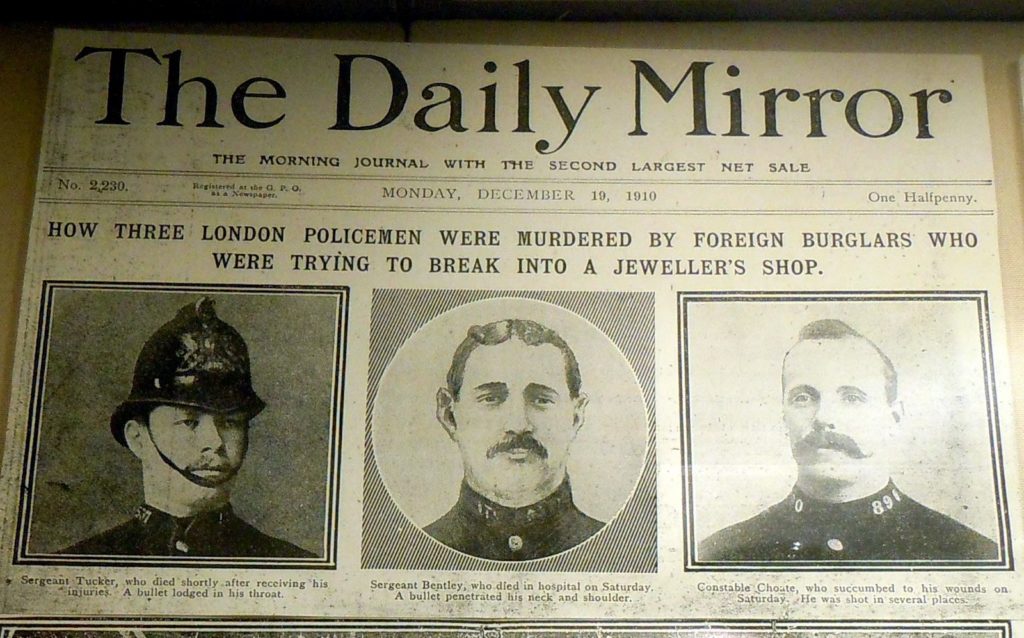
Late at night on a December evening in 1910, a group of heavily armed Latvian anarchists tunnelled their way into a jewellery shop in Houndsditch in the City of London (not far from Aldgate station).
Neighbours heard loud noises and reported the matter to the police.
When police arrived, the foreign revolutionaries escaped by murdering three unarmed policemen in a hail of bullets and injuring two other police officers.
Therefore, 16 December 1910 was, at the time, the worst day in the history of the British police force.
Police launched a massive hunt for the gang.
The Siege of Sidney Street 1911
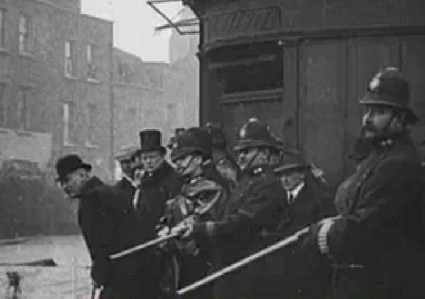
Eventually, an informer said that two of the anarchists were staying at 100 Sidney Street (between Mile End Road and Commercial Road) in London’s East End, which at that time, was home to a vast network of vicious political refugees.
The two desperate gunmen had Mauser automatic pistols, and they were ready for a fight to the death, if necessary.
The police, armed with antiquated weapons, were being outgunned and so they asked for troops to be sent to join the siege.
After a fierce gunfight lasting for several hours, the house eventually caught fire.
A bullet had punctured a gas pipe.
Eventually, firemen went into the house, and they found the two badly-charred bodies of the anarchists.
While the firefighters were sifting through the debris, part of the house collapsed.
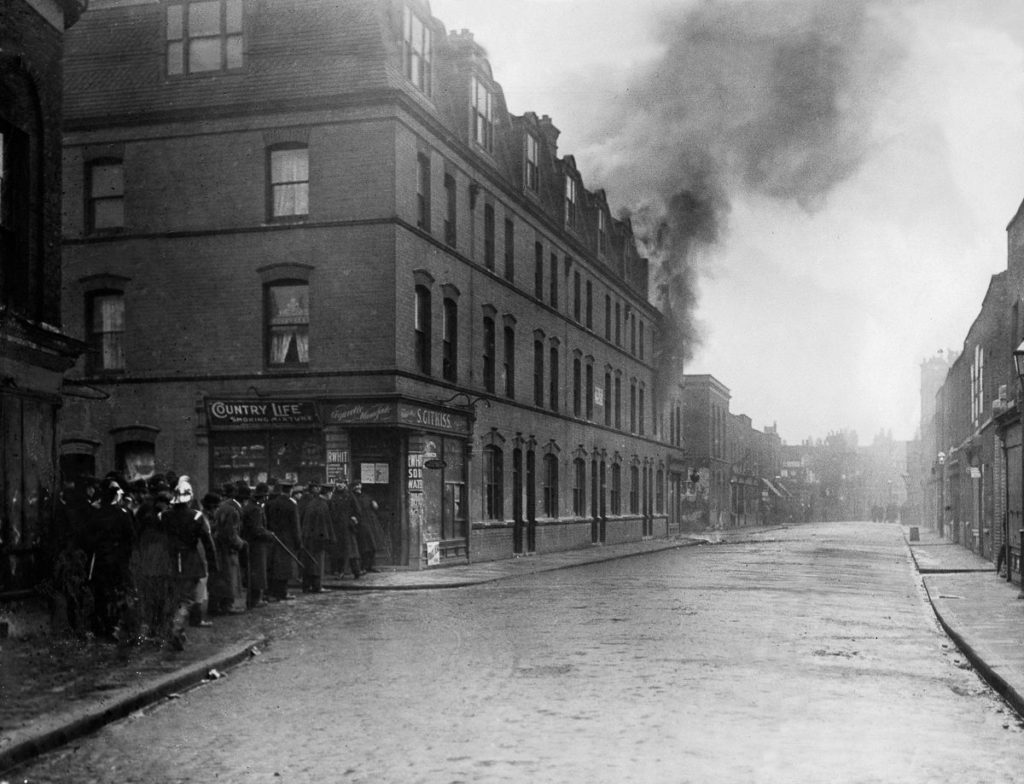
One of the firemen died from his injuries six months later.
Other members of the anarchist group were already in police custody.
The two anarchists died; one from smoke inhalation and the other from gunshot wounds.
Anarchy in the UK (1909-1911): Analysis
Before the First World War, Britain was the world’s leading economic power and the ruling elite had a national self-confidence.
They assumed that foreign anarchists were no threat to Britain.
The Liberal government welcomed anarchists from all over continental Europe.
Britain’s self-assurance which bordered on arrogance was responsible for this welcoming attitude towards political refugees.
This liberal ethos still exists to this day.
The government’s open-door policy towards political refugees had unanticipated consequences.
During the years 1909 to 1911, the ruthless anarchists left a trail of destruction throughout London
The British public came to realise that these political refugees were not the respectable dissidents of the early nineteenth century who had the courage to speak out against their repressive governments but were, in fact, anarchists who preached the overthrow of all governments by bombings, shootings, and assassinations.
All over Europe, terrorists killed innocent bystanders in cafes, theatres, and public places.
The Liberals wanted to maintain Britain’s history as a sanctuary for all the world’s oppressed.
They assumed that the majority of the people supported the ‘rebels’.
Furthermore, the Liberals assumed that the ‘rebels’ were only trying to overthrow their despotic governments or ruling dynasties.
They did not comprehend that the rebels could be representing a minority interest and that an oppressive regime might be replaced by an even more oppressive regime.
The above incidents all happened over 100 years ago.
It all sounds depressingly similar to the events taking place right now in 2017.
There may be some supporters of Britain’s current open-door policy on asylum who have good intentions, but the road to hell is paved with good intentions.


